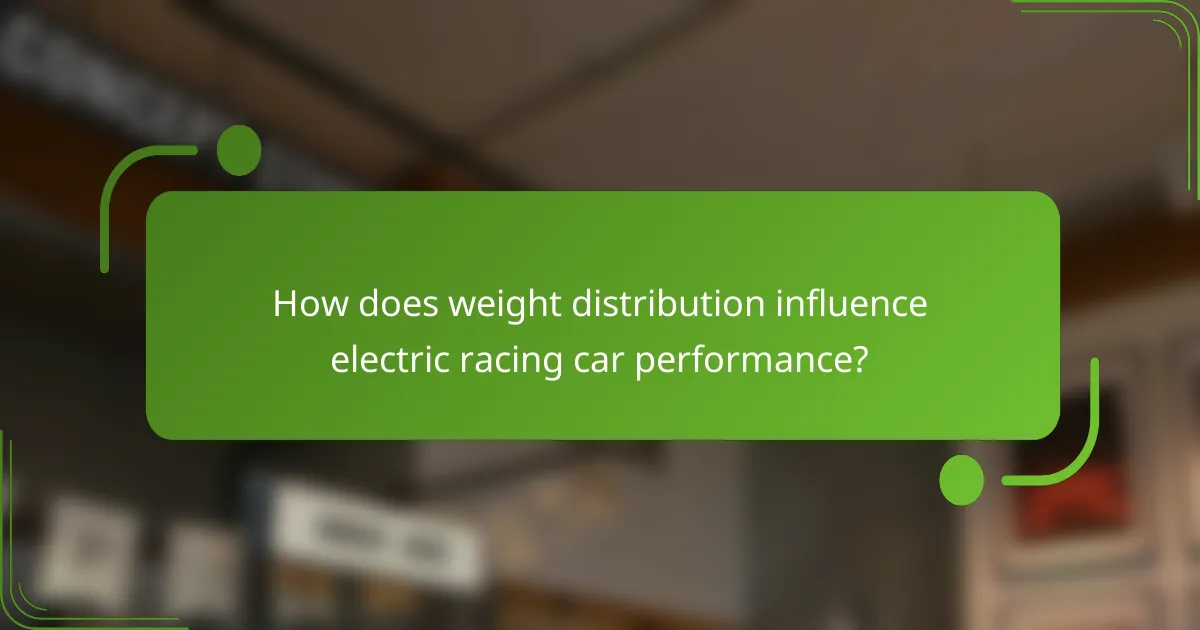Electric racing cars are defined by their battery capacity, which directly impacts performance and endurance on the track. A higher battery capacity not only extends race durations but also influences weight distribution and torque delivery, both of which are critical for achieving optimal acceleration and handling. Effective torque delivery enables rapid acceleration, while balanced weight distribution enhances stability and cornering capabilities, making these factors essential for competitive racing success.

How does battery capacity affect electric racing cars in Canada?
Battery capacity significantly influences the performance and endurance of electric racing cars in Canada. A higher capacity allows for longer race durations and can impact overall vehicle dynamics, including weight distribution and torque delivery.
Higher capacity enables longer race durations
A larger battery capacity directly correlates with extended race times, allowing drivers to cover more distance without needing to recharge. In competitive racing, where every second counts, this can be a critical advantage. For example, electric racing cars with battery capacities in the range of 60-100 kWh can often sustain races lasting over an hour, depending on the track and driving style.
Impact on vehicle weight and performance
Increased battery capacity typically results in added weight, which can affect acceleration and handling. Electric racing cars must balance battery size with vehicle weight to optimize performance. A well-distributed weight can enhance stability, while excessive weight can hinder speed and agility on the track.
Manufacturers often design lightweight materials and advanced battery technologies to mitigate these effects, aiming for a weight distribution that supports both speed and control. For instance, a well-optimized electric racing car may achieve a weight distribution of around 50-50, enhancing cornering performance.
Examples of top battery technologies
Several cutting-edge battery technologies are currently leading the electric racing scene. Lithium-ion batteries remain the most common due to their high energy density and efficiency. However, newer technologies like solid-state batteries are emerging, promising even greater energy capacity and safety.
In Canada, companies are exploring various battery chemistries to enhance performance. For example, some teams are experimenting with lithium-sulfur batteries, which can potentially offer higher capacities and lighter weights compared to traditional lithium-ion options.

What is the role of torque delivery in electric racing cars?
Torque delivery is crucial in electric racing cars as it directly affects acceleration and overall performance. High torque allows for rapid acceleration from a standstill, giving electric vehicles a competitive edge on the track.
Instant torque for rapid acceleration
Electric racing cars benefit from instant torque, which is available immediately upon acceleration. Unlike traditional combustion engines that require time to build up power, electric motors deliver maximum torque from zero RPM, enabling quick starts and swift overtaking maneuvers.
This instant response can significantly reduce lap times, making it essential for competitive racing. Drivers can expect to achieve 0-60 mph in just a few seconds, depending on the model and conditions.
Comparison of torque delivery in leading models
Leading electric racing cars exhibit varying torque delivery characteristics, impacting their performance on the track. For instance, models like the Rimac C_Two and Tesla Model S Plaid showcase impressive torque figures, often exceeding 1,000 Nm, allowing for exceptional acceleration.
When comparing these models, consider factors such as weight distribution and battery capacity, which can influence how effectively torque is harnessed during a race. A well-balanced vehicle with a high torque-to-weight ratio can outperform others, particularly in tight corners and during quick acceleration phases.

How does weight distribution influence electric racing car performance?
Weight distribution significantly affects the handling, stability, and overall performance of electric racing cars. Properly balanced weight can enhance cornering capabilities and improve acceleration, while poor distribution can lead to handling issues and increased tire wear.
Optimal weight distribution for handling
For electric racing cars, an optimal weight distribution typically ranges from 40-60% front to rear. This balance allows for better traction during acceleration and improved cornering stability. Adjusting the weight distribution can be achieved by repositioning components such as the battery, which is often the heaviest part of the vehicle.
A front-heavy distribution may enhance initial turn-in response but can lead to understeer, while a rear-heavy setup can improve rear grip but may cause oversteer. Fine-tuning this balance is crucial for achieving the desired handling characteristics on different tracks.
Effects on tire wear and stability
Weight distribution directly impacts tire wear patterns, with uneven distribution leading to accelerated wear on specific tires. For instance, a car with too much weight on the front tires may experience faster degradation of those tires, resulting in inconsistent performance during a race.
Maintaining a balanced weight distribution helps ensure even tire wear and prolongs tire life, which is essential for maintaining competitive lap times. Regularly monitoring tire pressure and tread depth can also aid in assessing the impact of weight distribution on tire performance.

What are the key specifications of popular electric racing cars?
Key specifications of popular electric racing cars include battery capacity, torque delivery, and weight distribution, which significantly influence performance and handling. Understanding these factors helps in evaluating the capabilities and suitability of different models for racing scenarios.
Specifications of the Porsche Taycan
The Porsche Taycan features a battery capacity ranging from approximately 79 kWh to 93 kWh, depending on the variant. This capacity allows for a competitive range and performance, with torque delivery peaking at around 1,050 Nm in the Turbo S model, providing rapid acceleration.
Weight distribution is also a critical aspect of the Taycan’s design, with a near 50-50 balance between the front and rear axles. This balance enhances handling and stability, making it well-suited for high-speed cornering on racetracks.
Specifications of the Tesla Model S Plaid
The Tesla Model S Plaid boasts a substantial battery capacity of about 100 kWh, enabling impressive range and performance metrics. It delivers a staggering torque of up to 1,420 Nm, allowing for exceptionally quick acceleration times, often under 2 seconds for 0-60 mph.
In terms of weight distribution, the Model S Plaid also aims for a balanced setup, although it may slightly favor the rear due to the placement of its battery pack. This distribution contributes to its dynamic handling characteristics, especially during aggressive driving maneuvers.

How do electric racing cars compare to traditional racing cars?
Electric racing cars differ from traditional racing cars primarily in their power sources and performance characteristics. While electric cars rely on battery capacity and torque delivery for acceleration, traditional cars depend on internal combustion engines, which offer different weight distribution and handling dynamics.
Performance metrics comparison
Electric racing cars typically excel in torque delivery, providing maximum torque instantly, which results in rapid acceleration. This characteristic allows electric vehicles to achieve impressive 0-60 mph times, often in the low seconds range, compared to traditional cars that may take longer due to engine rev-up times.
Weight distribution also plays a crucial role in performance. Electric cars generally have a lower center of gravity due to battery placement, enhancing stability and cornering capabilities. Traditional racing cars, while lighter, may struggle with balance under high-speed conditions.
Cost analysis of electric vs. traditional racing
The initial investment for electric racing cars can be higher due to the cost of advanced battery technology and electric drivetrains. However, operational costs may be lower over time, as electric vehicles typically require less maintenance and have lower fuel costs compared to gasoline-powered counterparts.
In terms of racing events, entry fees and regulations may vary. Some circuits offer incentives for electric vehicles, while others may impose additional fees for traditional racing cars due to fuel consumption regulations. Teams should consider these factors when budgeting for a season.

What are the prerequisites for entering electric racing?
To enter electric racing, participants need to understand specific regulations, standards, and the necessary equipment and technology. Familiarity with these prerequisites ensures compliance and enhances performance on the track.
Understanding regulations and standards
Electric racing is governed by a set of regulations that vary by organization and event. Key standards often include safety protocols, vehicle specifications, and environmental considerations. For instance, the FIA has established guidelines for electric vehicles that cover battery capacity and weight distribution.
Participants should review the regulations of their specific racing series, as they may dictate aspects such as maximum battery voltage, torque delivery limits, and weight distribution requirements. Compliance with these standards is crucial for eligibility and safety during races.
Required equipment and technology
Essential equipment for electric racing includes a high-performance battery system, advanced torque delivery mechanisms, and a lightweight chassis. The battery capacity typically ranges from 20 kWh to 100 kWh, depending on the race format and vehicle design.
In addition to the battery, teams must invest in technology that optimizes weight distribution and enhances aerodynamics. This includes using lightweight materials and sophisticated telemetry systems to monitor vehicle performance in real-time. Understanding these components will help teams maximize their competitive edge on the track.

What emerging trends are shaping the future of electric racing?
Emerging trends in electric racing are significantly influenced by advancements in battery technology and the integration of artificial intelligence in racing strategies. These developments enhance performance, efficiency, and overall competitiveness in the sport.
Advancements in battery technology
Battery technology is crucial for electric racing, as it directly impacts performance metrics like capacity, weight distribution, and torque delivery. Modern electric racing cars often utilize lithium-ion batteries with capacities ranging from 50 kWh to over 100 kWh, allowing for longer race durations and faster charging times.
Weight distribution is another vital consideration; optimal placement of batteries can improve handling and stability. Manufacturers are experimenting with solid-state batteries, which promise higher energy densities and faster charging, potentially revolutionizing the racing landscape.
Integration of AI in racing strategies
Artificial intelligence is increasingly being used to refine racing strategies, optimizing everything from energy management to real-time decision-making during races. AI algorithms can analyze vast amounts of data, helping teams predict tire wear and adjust power delivery for maximum efficiency.
By leveraging AI, teams can simulate various race scenarios, allowing for better preparation and strategy development. This technology not only enhances performance but also provides insights that can lead to more sustainable racing practices, aligning with the growing emphasis on environmental responsibility in motorsports.
